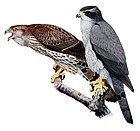Buteogallus
| Buteogallus Temporal range: Middle Miocene to present
| |
|---|---|

| |
| Great black hawk (Buteogallus urubitinga) | |
| Scientific classification | |
| Domain: | Eukaryota |
| Kingdom: | Animalia |
| Phylum: | Chordata |
| Class: | Aves |
| Order: | Accipitriformes |
| Family: | Accipitridae |
| Subfamily: | Buteoninae |
| Genus: | Buteogallus Lesson, RP, 1830 |
| Type species | |
| Buteogallus cathartoides[1] = Falco aequinoctialis Lesson, 1830
| |
| Species | |
|
see text | |
| Synonyms | |
|
Alectromorphnus Heine & Reichenow, [1890] | |
Buteogallus is a genus of birds of prey in the family Accipitridae. All members of this genus are essentially neotropical, but the distribution of a single species extends slightly into the extreme southwestern United States. Many of the species are fond of large crustaceans and even patrol long stretches of shore or riverbank on foot where such prey abounds, but some have a rather different lifestyle. Unlike many other genera of raptor, some members are referred to as "hawks", and others as "eagles".
Most of the species have a characteristic tail pattern. This consists of a black base, a wide white middle band, a wide black band, and a quite narrow white band on the feathertips that is often hard to discern or may be lost when the feathers are very worn. Only the white-necked hawk and the rufous crab hawk have a very different tail patterns (see also below).
Taxonomy
The genus Buteogallus was introduced in 1830 by the French naturalist René Lesson to accommodate the rufous crab hawk, which is therefore the type species.[2][3] The name is a portmanteau of the genus name Buteo introduced in 1779 by Bernard Germain de Lacépède for the buzzards and the genus Gallus introduced in 1760 by Mathurin Jacques Brisson for the junglefowl.[4] The genus now contains nine species.[5]
Harpyhaliaetus is a former genus of eagles described by Frédéric de Lafresnaye in 1842. Two species were recognized: Harpyhaliaetus coronatus and Harpyhaliaetus solitarius. However, more recent studies have led to this genus being merged into Buteogallus.
Species
| Common name | Scientific name and subspecies | Range | Size and ecology | IUCN status and estimated population |
|---|---|---|---|---|
| Slate-colored hawk | Buteogallus schistaceus (Sundevall, 1850) |
Brazil, Bolivia, Peru, Ecuador, Colombia, Venezuela, and French Guiana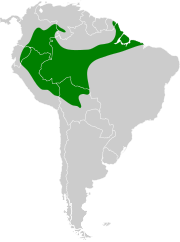
|
Size: Habitat: Diet: |
LC
|
| White-necked hawk | Buteogallus lacernulatus (Temminck, 1827) |
Brazil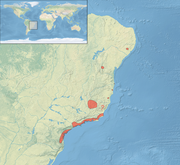
|
Size: Habitat: Diet: |
VU
|
| Rufous crab hawk | Buteogallus aequinoctialis (Gmelin, JF, 1788) |
eastern Venezuela, Trinidad and Tobago to southern Brazil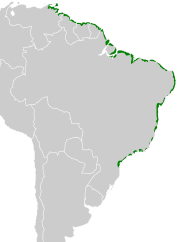
|
Size: Habitat: Diet: |
NT
|
| Common black hawk | Buteogallus anthracinus (Deppe, 1830) Five subspecies
|
Southwestern United States through Central America to Venezuela, Peru, Trinidad, and the Lesser Antilles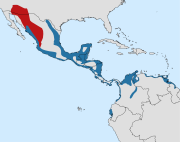
|
Size: Habitat: Diet: |
LC
|
| Cuban black hawk | Buteogallus gundlachii (Cabanis, 1855) |
Cuba
|
Size: Habitat: Diet: |
NT
|
| Great black hawk | Buteogallus urubitinga (Gmelin, JF, 1788) Two subspecies
|
Mexico through Central America to Peru, Tobago and northern Argentina.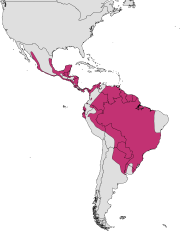
|
Size: Habitat: Diet: |
LC
|
| Savanna hawk | Buteogallus meridionalis (Latham, 1790) |
Panama and Trinidad south to Bolivia, Uruguay and central Argentina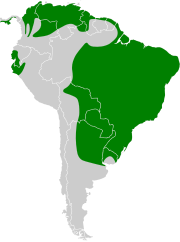
|
Size: Habitat: Diet: |
LC
|
| Chaco eagle | Buteogallus coronatus (Vieillot, 1817) |
southern and central Brazil, Bolivia, Paraguay and its range extends to Northern Patagonia in Argentina
|
Size: Habitat: Diet: |
EN
|
| Solitary eagle | Buteogallus solitarius (Tschudi, 1844) Two subspecies
|
Mexico and Central and South America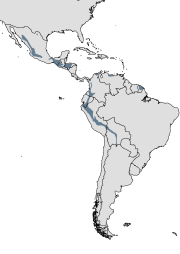
|
Size: Habitat: Diet: |
LC
|
The solitary eagles (formerly Harpyhaliaetus) are a more inland relative of the "black-hawk" group of Buteogallus – in phenotype they are essentially hefty common black-hawks with lighter body plumage and in one species a small crest. Insofar as there are differences in anatomy, these seem to be related to the different prey they hunt (namely reptiles). Together with the savanna hawk, they seem to be close to some species that were uncomfortably placed in Leucopternis. As that genus was apparently polyphyletic, the present article follows a proposal to unite the solitary eagles as well as the slate-colored hawk ("Leucopternis" schistaceus) with Buteogallus, to agree with the morphological and mtDNA sequence data.,[6][7] with the addition of the white-necked hawk, "Leucopternis" lacernulatus.[8]
For a long time various systematists have proposed moving the slate-colored hawk to Buteogallus. Together with the crab hawks and solitary eagles form a sequence of plumage patterns that nicely agrees with the DNA-based phylogeny: the slate-colored hawk looks very much like a smaller, shorter-legged and lighter common black hawk. The case of the white-necked hawk is more puzzling. It is visually and ecologically almost identical to the sympatric mantled hawk (Leucopternis polionotus) and some allopatric white hawks (L. albicollis) but differs in tail color. According to the mtDNA data, it is very closely related to the savanna hawk, which is visually dissimilar, appearing like a very light Buteogallus which has an ochre-grey coloration due to abundant pheomelanins. Either there has been strong convergent evolution in plumage and ecology – perhaps a case of mimicry – between the white-necked and the mantled hawks, or the mtDNA data is misleading due to ancient hybrid introgression. In the respect, the white-necked hawk specimen sampled showed indications of heteroplasmy.[6]
The placement of the peculiarly apomorphic rufous crab hawk in regard to all these birds must be considered unresolved for the time being.[6]
Fossil record

The fossil record of Buteogallus has meanwhile turned out to be quite rich indeed, with many species being erroneously assigned to other genera at first. The genus – like many buteonines of today – probably succeeded earlier birds of prey during the Miocene and never seems to have occurred outside the Americas. From the time of the last ice age, an array of prehistoric species is known, some of them very large. On Cuba, a particularly gigantic species survived deep into the last ice age, but probably not until human settlement.
- †Buteogallus enectus (Middle Miocene; Sheep Creek, Sioux County, USA)
- †Buteogallus sodalis (Middle Pleistocene; Fossil Lake, Oregon) – formerly in Aquila
- †Buteogallus fragilis (Late Pleistocene; Southwestern USA) – formerly in Buteo or Geranoaetus
- †Buteogallus milleri (Late Pleistocene of Southwestern, USA) – formerly in Buteo or Geranoaetus
- †Buteogallus royi (Late Pleistocene of Cuba)
- †Buteogallus borrasi (prehistoric) – formerly in Aquila or Titanohierax
- †Buteogallus daggetti (prehistoric)
- †Buteogallus woodwardi (Late Pleistocene, Southwestern USA) – formerly Amplibuteo
- †Buteogallus hibbardi (Late Pleistocene, Peru) – formerly Amplibuteo
- †Buteogallus concordatus (Late Pliocene of Florida) – formerly Amplibuteo
- †Buteogallus irpus (Late Pleistocene of Cuba and Dominican Republic)
References
- ^ "Accipitridae". aviansystematics.org. The Trust for Avian Systematics. Retrieved 26 July 2023.
- ^ Lesson, René (1831). Traité d'Ornithologie, ou Tableau Méthodique (in French). Paris: F.G. Levrault. p. 83. Published in 8 livraisons between 1830 and 1831. For the publication date see: Dickinson, E.C.; Overstreet, L.K.; Dowsett, R.J.; Bruce, M.D. (2011). Priority! The Dating of Scientific Names in Ornithology: a Directory to the literature and its reviewers. Northampton, UK: Aves Press. p. 119. ISBN 978-0-9568611-1-5.
- ^ Mayr, Ernst; Cottrell, G. William, eds. (1979). Check-List of Birds of the World. Vol. 1 (2nd ed.). Cambridge, Massachusetts: Museum of Comparative Zoology. p. 356.
- ^ Jobling, James A. (2010). The Helm Dictionary of Scientific Bird Names. London: Christopher Helm. p. 81. ISBN 978-1-4081-2501-4.
- ^ Gill, Frank; Donsker, David; Rasmussen, Pamela, eds. (August 2022). "Hoatzin, New World vultures, Secretarybird, raptors". IOC World Bird List Version 12.2. International Ornithologists' Union. Retrieved 7 December 2022.
- ^ a b c Raposo do Amaral FS, Miller MJ, Silveira LF, Bermingham E, Wajntal A (2006). "Polyphyly of the hawk genera Leucopternis and Buteogallus (Aves, Accipitridae): multiple habitat shifts during the Neotropical buteonine diversification". BMC Evol. Biol. 6 (1): 10. Bibcode:2006BMCEE...6...10D. doi:10.1186/1471-2148-6-10. PMC 1413559. PMID 16464261.
- ^ Raposo do Amaral, F. S.; et al. (2009). "Patterns and processes of diversification in a widespread and ecologically diverse avian group, the buteonine hawks (Aves, Accipitridae)". Molecular Phylogenetics and Evolution. 53 (3): 703–715. Bibcode:2009MolPE..53..703D. doi:10.1016/j.ympev.2009.07.020. PMID 19635577.
- ^ Bierregaard, R. O. Jr.; Kirwan, G. M.; Christie, D. A. (2018). "White-necked Hawk (Buteogallus lacernulatus)". In del Hoyo, J.; Elliott, A.; Sargatal, J.; Christie, D. A.; de Juana, E. (eds.). Handbook of the Birds of the World Alive. Retrieved 17 April 2018.












